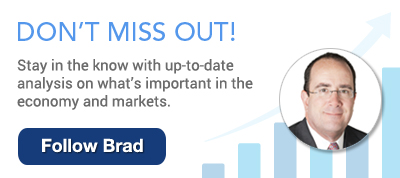 I’ve been traveling this week, spending a day in Washington talking with the press and then speaking this morning at the Financial Planning Association conference. These trips are always useful in that I get a chance to bounce ideas off a lot of people in the real world. They can also be surprising. Not so much in the questions I’m asked—people are worried about the economy, worried about the markets, wondering what’s next—but in what comes out of my mouth when I answer them.
I’ve been traveling this week, spending a day in Washington talking with the press and then speaking this morning at the Financial Planning Association conference. These trips are always useful in that I get a chance to bounce ideas off a lot of people in the real world. They can also be surprising. Not so much in the questions I’m asked—people are worried about the economy, worried about the markets, wondering what’s next—but in what comes out of my mouth when I answer them.
As I’ve noted before, it's worthwhile to consider what no one is really talking about and then pay attention to that. My subconscious has apparently been taking that idea seriously, as I’ve found myself laying out a case for a much better economy and market, at least over the next couple of years.
Reasons for optimism
Election could boost government spending. Generally, the discussion about the election and the economy has focused on the risks associated with the candidates and their policies. Is there any upside? In fact, there is. Both candidates are highly likely to put more government spending in place, albeit in different ways. Private growth actually hasn’t been bad over the past several years; one of the major factors restricting the economy has been slow government spending growth. That could well end, turning an economic headwind into a tailwind.
Business investment might pick up. Another headwind has been slow business investment. Companies have been able to expand by hiring rather than investing. The ability to throw bodies at the problem is eroding, though, as the labor market tightens—and investment is becoming more necessary as consumer spending continues to rise. Could business investment be poised to recover?
As both of these areas improve, workers and consumers should do even better. With household income rising, and likely to continue to do so, consumers will be able and willing to spend more, finally kicking off the virtuous growth cycle we’ve been waiting for. 2017 might finally be the year that the growth rate picks up enough to make people feel good.
Market could keep right on climbing. And if people feel good, that tends to be good for the financial markets. As high as the market is now, it could continue to run higher, pushed by faster growth, rising confidence, and continued low rates. We’ve been living with crisis worries for so long that something approaching normality would look just wonderful.
Okay, but will this really happen?
In some respects, today looks like 1997 or perhaps 2005. Markets have run up, but steady economic improvement is finally hitting the general population, which is now poised to take advantage of it. We may be setting up for a good year or two as people finally stop worrying so much. Of course, that absence of worry will create its own problems in a couple of years.
I’m not sure just how serious I am about all this. Recent economic news has been discouraging and moving in the wrong direction, even though the fundamentals remain solid overall. I’m not making a prediction, but ongoing improvement does make a certain sense. Plus, no one seems to be talking about a potential boom, which gives it a contrarian appeal.
We’ll explore this idea in a bit more depth over the next couple of weeks. At a minimum, it makes sense to at least consider it, as this could be the bus no one is watching for.


 Print
Print

